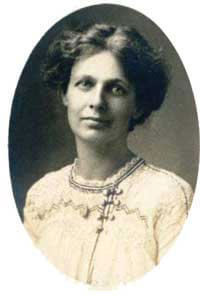Margaret Ellen Wright was born in Weymouth, Massachusetts, on June 19, 1881. When she was a young child, her parents separated, and she, her mother, and her brother moved to Wisconsin. It was there that Margaret, nicknamed Maginel, grew up in Madison with her extended family, the Lloyd-Joneses. She came to appreciate Wisconsin’s scenic nature and bustling farm life. When her brother, Frank Lloyd Wright, moved to Chicago for his burgeoning architectural career, Maginel and her mother moved with him. However, she repeatedly returned to Madison throughout her lifetime, the area too significant to her to leave behind forever.
After graduating from her aunts’ school in 1897, Wright attended the School of the Art Institute of Chicago (SAIC), one of the most prestigious fine art colleges in the United States. However, she was unable to continue after her first year because the tuition was too expensive. After withdrawing from SAIC, she worked for three years at an engraving company, where she illustrated figures for modeling clothes.
In 1904, Wright married fellow cartoonist Walter “Pat” Enright. In 1907, she gave birth to a daughter, Elizabeth, and the couple relocated to New York City to further develop their budding careers. It was there that she began to flourish as an artist. During her cartoon career, Wright and Enright divorced, and she later married Hiram Barney, taking his last name.
Barney often illustrated children’s books and magazines, such as The Ladies’ Home Journal, a common practice for women artists at the time. Her art style was distinctive due to the soft, bright colors and minimal shading she used. During World War I, she painted patriotic cartoons. For instance, her work Follow The Pied Piper, Join the United States School Garden Army depicts Uncle Sam as the Pied Piper, followed by young children carrying gardening tools and planting seeds. The goal was to encourage people to grow victory gardens, which were community gardens used to produce more food for the wartime effort and boost morale.
During the Great Depression, her art took the form of colorful “long-point” tapestries that depicted natural scenery. Barney sometimes made clothes for her friends, and in the 1940s, she designed a custom line of shoes with the manufacturer Capezio. This line was a newly emerging style of ballet flats that she embellished by hand with steel embroidery and faux jewels. Towards the end of her life, she wrote a memoir titled The Valley of the God-Almighty Joneses, published in 1965.
On April 18, 1966, Maginel Wright Barney died in Long Island, New York.
LEARN MORE
Barney, Maginel Wright. Follow the Pied Piper. Join the United States School Garden Army, 1919, Library of Congress Prints and Photographs Division, Washington, D.C., USA. https://www.loc.gov/resource/ppmsca.53320/.
Barney, Maginel Wright, and Tom Burke. The Valley of the God-Almighty Joneses: Reminisces of Frank Lloyd Wright’s Sister. Appleton-Century-Crofts, 1965.
Ergeg, “Maginel Wright’s Capezio Flats.” Sarara Vintages (blog), http://sararavintages.blogspot.com/2012/05/maginel-wright-barney-capezio-flats.html.
Piece by Maginel Wright-Enright, Keiran Murphy. https://www.keiranmurphy.com/history-of-native-americans-in-the-valley/magineltapestrywwriting_/.
Woman’s Home Companion, December 1932. https://archive.org/details/WomansHomeCompanion193212.
Photo courtesy of the Nantucket Historical Society.
Profile written by Amelia Stephens, student coordinator for Wisconsin Women Making History.
